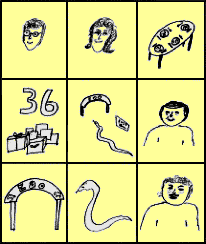May 14-15, 2005. Tokyo, Japan: Tokyo Keizai University.
Discovering the magic of Harry Potter:
by Junko Matsuzaki-Carreira (Keiai University)
|
|
Keywords: drama method, Harry Potter, elementary EFL instruction, student motivation |
Discovering the magic of Harry Potter:
by Junko Matsuzaki-Carreira (Keiai University)
|
|
Keywords: drama method, Harry Potter, elementary EFL instruction, student motivation |
[ p. 10 ]
| . . .drama methods encourage children to speak and provide them with the chance to communicate, using non-verbal communication, such as body movements and facial expressions. |
[ p. 11 ]
| Teaching language through drama . . . forc[es] the learners to use their language resource |
[ p. 12 ]
| My name is Harry. This is my uncle. This is my aunt. This is my cousin, Dudley. Dudley got 36 presents this year. We are eating breakfast. We went to the zoo yesterday. I saw a snake. The snake ran out of the zoo. |

[ p. 13 ]
Writing and reading practice| Q: Who is that man? | A: This is my ( ). |
| Q: Who is that woman? | A: This is my ( ). |
| Q: Who is that boy? | A: This is my ( ), Dudley. |
| Q: Do you like them? | A: No, I don't. They are ( ) to me. |
| Q: Where did you go on Dudley's birthday? | A: We ( ) to the ( ). |
| Q: What did you see? | A: I ( ) a ( ). |
| Q: What did you do? | A: I ( ) with a snake. |
[ p. 14 ]
Evaluation by the students![ハリーポッターは楽しいから英語をよくおぼえられると思う。
[Harry Potter is very fun so I can learn English very well.]
ハリーポッターは楽しくてわかりやすい。
[Harry Potter is fun and easy to understand.]
ハリーポッターになって答えたりするのがとてもおもしろかった。
[Answering questions while pretending to be Harry was very fun.]
もっとハリーポッターを使った授業がやりたいです。
[I want to do more activities using Harry Potter.]
ハリーポッターは英語を話す国のことを勉強できるからいいと思う。
[Harry Potter is good because I can learn about the country where English is spoken.].
もっとイギリスのことを知りたい。
[I want to know about Britain more.]
いつか絶対にイギリスに行ってみたい。
[I definitely want to go to Britain someday.]](../Graphics/MatsuzakiT3.gif)
[ p. 15 ]
| By acting out . . . [a character], it seems that some students gain a deeper sense of empathy with him and awareness of factors that seldom develop just from passive viewing. |
[ p. 16 ]
[ p. 17 ]